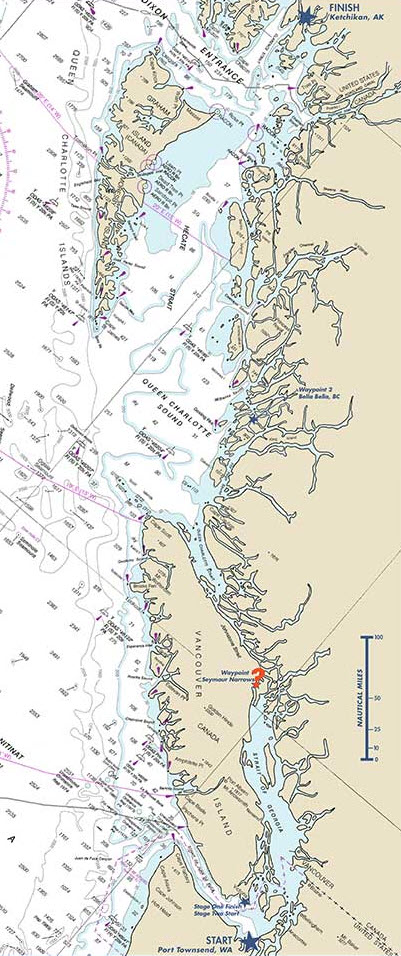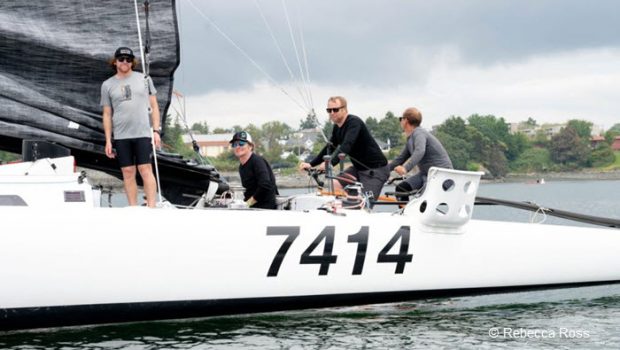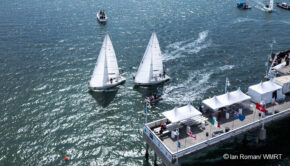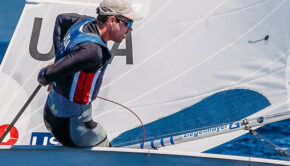R2AK: Wood is not good
Published on June 17th, 2022
After the race was cancelled in 2020 and 2021, the 6th edition of the 750 mile Race to Alaska (R2AK) began June 13 with a 40-mile “proving stage” from Port Townsend, WA to Victoria, BC. For those that survived, they started the remaining 710 miles on June 16 to Ketchikan, AK. Here’s the day two report:
If BC’s timber industry cheerleaders are to be believed, British Columbia accounts for roughly 40% of Canada’s softwood lumber production. If racers, media boats, and the coastal BC community of pro mariners are to be believed, roughly 40% of that annual production is floating mid-race.
Unless you can see it, it’s hard to imagine, and even if you’ve been up the inside before, it’s hard to wrap your head around just how much driftwood is in the water right effing now. This spring’s record high tides coupled with the highest rainfall in a metric decade flooding coastal rivers mean most of us haven’t seen this many logs in the water since the beginning of the Obama administration—it’s been that long.
For all of you wondering why in the ever-loving Race to Alaska we’re talking about floating wood when there are teams racing to Alaska, you clearly haven’t been paying attention to the last 36-ish hours when at least three teams met enough driftwood, at enough speed, that it ended their race. Not just teams full of randos, but some of our fastest and favorites: Teams Pestou, Pturbodactyl, and Malolo.
Pout.
In past years, there has been a cavalier and chagrined punchline of pride between racers; the set up is some version of this:
Q: Isn’t there a lot of driftwood out there? How do you avoid it at night?
A: The logs just seem to go away at night.
While that arrogant bit of self-denial might have been true for the cocky/lucky in years past, what’s proving thematically true in 2022 is that like humans, Gremlins, and cockroaches, driftwood now seems to multiply after the sun goes down and seems to get multiply-er the further north teams go.
Trincomali Channel and the Southern Straits of Georgia were mine fields, but when one of the race’s media boats transited Dodd Narrows, the flow was a sluice gate of the chunky stuff. Professional mariners reporting from as far north as Malcolm Island have been slowing their boats to a dead stop so they could go bow and push apart the driftwood scrum and allow themselves to pass through.
While the internet debated what one would call a flock of floating logs (An obstruction of driftwood? An armada? A brutality?), for at least the teams who violently Marco Polo’d themselves into enough of a log to remove themselves from the race, the herd of wood can only be described as an inevitability:
• Team Pturbodactyl was first, hitting a family of would-be 2x4s with enough force that it damaged their amas and endangered its connection to their main hull.
• Team Pestou was next, bashing into at least five big ones on Stage Two’s first night, and with enough combined force that it delaminated an internal bulkhead (“boat wall” if you’re not into the whole nautical thing). That’s like t-boning a car and having your back window smash out. Enough force, and who knows what kind of damage has gone through the frame. Time to head for the barn.
• Team Malolo smashed at least one into at least their starboard ama at 2 am. Sailors in ocean races sleep with their feet forward just in case there is a collision. Why? You might sprain your ankle as you fly forward when your boat makes a slam stop into something—but at least you won’t break your neck. Experienced sailors all, no one was hurt on Malolo, but the fiberglass tip of the ama was bent like a boxer’s nose, and a stress fracture went top to bottom about 18” from where the punch landed. While it wouldn’t be good, it’s hard to know/easy to guess how bad it would be if the front fell off, but (and we stand by the first part of this sentence) it wouldn’t be good.
While all of them are heartbroken, for all of us in the command bunker Team Malolo is maybe the most. In 2019, their boat and the guts of their humans entered R2AK as Team Pear Shaped Racing. Class acts with local sailing cred and R2AK bonafides, they searched the globe for the perfect boat, found it in New Zealand, brought it home, then trained the hell out of it.
R2AK ‘19 saw them go from full speed to full stop after a middle of the night log strike in the middle of Hecate Strait. Cost them two hours, the difference between ten grand and steak knives.
Regardless of the reasons, having this year’s Sadism of Driftwood (… still working on the swap out for “flock”) take out the R2AK Defenders of the Inside feels like we need to run another round or two of clinical trials to prove out this year’s inside/outside challenge.
We’re not clinical physicianists or whatever, but QED all you like—at this point Team Pure and Wild seems like it’s racing against itself and the floating forests of Dunsinane, but it feels like there are too many false positives (negatives?) for science to pass judgment on whether the inside/outside routes are sufficiently proven as the cure-alls for R2AK.
While the Race’s (so far) less-lethal “Lumber Games” may have sounded the canon for some of this year’s top competitors up the inside, the outside crowd is plugging away and slaying the miles. As of this morning, Team Pure & Wild is off of Mquqᵂin/Brooks Peninsula, and posting speeds that are steady 7+. There are still 500 miles and a Calamity of Driftwood (still trying) between them and the finish line, but at this point, it looks like it’s their race to lose.
Further back, Team Kootenay Pedalwheelers have successfully cracked and repaired their rudder in the west coast Vancouver town that R2AK superfans may or may not call Ukulele. Ucluelet’s repair resources were ample, welcoming, and every bit of necessary to get the Flying Tiger back to open ocean operation. You need G5 underwater epoxy? Ucluelet will find you G5 underwater epoxy, because that’s how they do.
Zooming out, a gaggle of teams are within reach of this morning’s tidal gate at Seymour Narrows. Other than the Nozzle Wall of Driftwood (not getting better) and 500+ miles, teams Wraith 2AK, Lost But Don’t Care, High Seas Drifters, Vegemite Vigilantes, and Fashionably Late seem to be in contention for inside champions and (at least at this point) contenders for the cutlery, and legit winners depending on the state of readiness of Hecate Strait’s Log Armada.
Stay safe out there, racers. Sleep with your feet to the bow, wear your life helmet, stay warm, hydrate, and sunscreen. There are days to go and logs to dodge. Sail fast and dodge ‘em well.
Race details – Tracker – Facebook – Instagram
 Race to Alaska, now in its 6th year, follows the same general rules which launched this madness in 2015. No motor, no support, through wild frontier, navigating by sail or peddle/paddle (but at some point both) the 750 cold water miles from Port Townsend, Washington to Ketchikan, Alaska.
Race to Alaska, now in its 6th year, follows the same general rules which launched this madness in 2015. No motor, no support, through wild frontier, navigating by sail or peddle/paddle (but at some point both) the 750 cold water miles from Port Townsend, Washington to Ketchikan, Alaska.
To save people from themselves, and possibly fulfill event insurance coverage requirements, the distance is divided into two stages. Anyone that completes the 40-mile crossing from Port Townsend to Victoria, BC can pass Go and proceed. Those that fail Stage 1 go to R2AK Jail. Their race is done. Here is the 2022 plan:
Stage 1 Race start: June 13 – Port Townsend, Washington
Stage 2 Race start: June 16 – Victoria, BC
There is $10,000 if you finish first, a set of steak knives if you’re second. Cathartic elation if you can simply complete the course. R2AK is a self-supported race with no supply drops and no safety net. Any boat without an engine can enter.
In 2019, there were 48 starters for Stage 1 and 37 finishers. Of those finishers, 35 took on Stage 2 of which 10 were tagged as DNF. There were no races in 2020 and 2021 due to the pandemic.
Source: R2AK









 We’ll keep your information safe.
We’ll keep your information safe.